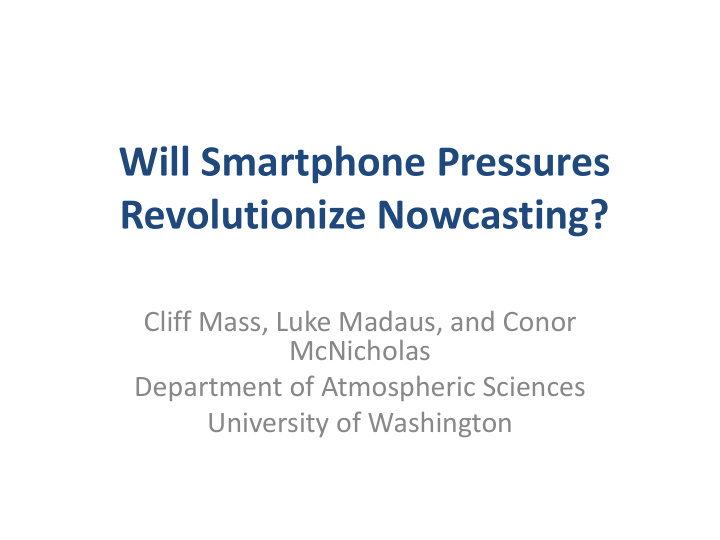



Will Smartphone Pressures Revolutionize Nowcasting? Cliff Mass, Luke Madaus, and Conor McNicholas Department of Atmospheric Sciences University of Washington
Question Can Real-Time Pressure Observations from Hundreds of Millions or Billions of Smartphones Improve Nowcasting and Short-term Prediction?
Billions Sold There are now over 1 billion smartphones in operation and that number should be over 2 billion by 2017
Pressure Sensors • 25-50% of these phones have pressure sensors • So we are talking about hundreds of millions of real-time pressure sensors , perhaps as high as a billion by the end of 2017.
Smartphone Pressure Sensors • Absolute accuracy ~+- 2 hPa • Relative accuracy ~+- .1 hPa • Thus, quite good for pressure change . • Smartphones also have GPS and cell tower location services (good to within 10s of meters) • Also accelerometers, light sensors, and internal temperature sensors
Some of the smartphones/pads with pressure sensors • iPhone 6 • Samsung Galaxy III, IV, V, VI • Nexus 4 and 10 • Some Sony, Nokia, and Chinese phones
Who is collecting smartphone pressure observations ? • Several small private sector firms have been collecting pressure through their apps – Cumulonimbus Inc. (PressureNet): Terminated – Opensignal, Inc. (WeatherSignal) • Some new firms has started to collect pressures (e.g., Dark Sky app) • Unfortunately, these firms have only collected a small proportion (1/1000) of the possible pressure observations.
114K Pressures in One Hour over US: A Very Small Proportion
Where would smartphone pressures have the biggest impact? • Countries with poor observational density but where they are a lot of smartphones • Locations where there is insufficient mesoscale data for initialization • For mesoscale phenomena sensitive to mesoscale initial conditions • Mesoscale features that have persistent structures (e.g., dry lines)
Conventional (Left), Smartphone (right)
Conventional (left), Smartphone (right)
What is the Value of Smartphone Pressures for Numerical Weather Prediction?
Pressure Is the Most Valuable Surface Variable for Assimilation • The one surface parameter that provides information about the full vertical column of the atmosphere. • Less sensitive to representativeness error than most variables. • Exposure is less of a problem (e.g., inside or outside of buildings) • Bias and systematic error relatively easy to remove
Proven Value for Global NWP Assimilation • Example: 20 th century reanalysis (Whitaker et al 2004) All observations Only surface pressure
But What About the Mesoscale? Both pressure/altimeter and 1-h pressure tendencies (METAR ONLY) improved coarse (30-km) forecasts of cold pools of two convective events in an EnKF system (Wheatley and Stensrud 2010)
Recent work is even more suggestive of benefit (later in this talk)
Issues • Use the pressure, pressure change, or both? • Need software to determine when phones are moving. • What is the best way to determine phone altitude? GPS and terrain maps, phone pressures, or ? • Calibration. • Can we prove that very dense pressure networks can substantially improve mesoscale prediction?
Quality Control of Pressure Observations: An Essential Step • Range check (880-1100 hPa) • Bias correction – Many smartphone pressure observations have biases (e.g., elevation problem, sensor calibration) – Most biases are systematic and constant and can be removed. – Made use of regional pressure analysis and note biases over an extended period. – Buddy checks • Movement check for pressure change.
University of Washington 36-4 km Testbed • DART EnKF Assimilaton 4-km System • WRF Model • Run in real-time operationally 36-km and for test periods.
Convergence Zone Case • A “ poorly-forecast ” convergence zone forms around 1400 UTC (6AM PDT) and moves south across north Seattle during the morning commute
3-hour forecasts from fully cycled EnKF of simulated composite reflectivity valid at 1500 UTC, Oct. 24, 2011 With Smartphones
What about nowcasting wind energy in the Columbia River Gorge?
12-hour Nov. 17, 1800 Forecasts UTC Frontal Passage Case • WRF U-wind component (m/s) for METAR only and All Altimeters Only cases with 5-minute observations • Timing of frontal passage improved by 20-45 minutes
Might Smartphones Provide Crucial Data for Short-Term Convective Forecasts, Particularly in Areas of Low Density of Observations? • Better define confluence lines, dry lines, preexisting cold pools, etc. BEFORE convection starts? • Define cold pool structure, gust fronts, etc. after convection forms.
Smartphone Pressure Tendency
A Poorly Forecast Convective Case
Improved Pressure Forecasts Verified with Unassimilated Observations Smartphone pressures assimilated in a 1-h cycled EnKF system using WRF
Improves Short-Term (1-hour) Precipitation Forecast
The Big Question: How Can We Collect Large Numbers of Smartphone Pressures? • Only a few small apps are collecting smartphone pressure information today. • Would be useful if major operating systems (e.g., Android, iOS) or hardware manufacturers would help. • Or help from a very big app used by millions of people. • Now working with one possible group.
To experiment and test ideas, we developed our OWN smartphone weather app: uWx Android On Google Play
More information at: https://www.cmetwx.com/
Conclusions • Millions or even billions of pressure observations could be available globally from smartphones • Both pressure and pressure change can be acquired in real time. • Studies of the impacts of dense pressure observations on mesoscale analysis and prediction look promising. • We need a way to collect a higher percentage of the smartphone pressure observations and test their value for nowcasting and short-term forecasting .
The End
Recommend
More recommend